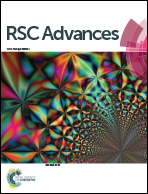Synthetic cobalt clays for the storage and slow release of therapeutic nitric oxide†
Abstract
Nitric oxide (NO) is one of the smallest endogenous molecules with particularly interesting aspect roles in biological systems, despite its toxicological potential. Solid carriers have potential biomedical interest in the delivery of exogenous NO for anti-bacterial, anti-thrombic and wound healing applications. In this work, a smectite clay was successfully synthetized with incorporated cobalt ions in its structure, with the main goal of studying its potential in the field of storage and release of nitric oxide for therapeutic applications. Materials were characterized by X-ray diffraction, nitrogen adsorption at −196 °C, TG-DSC and chemical analysis. The kinetic data for the nitric oxide storage and release was obtained in gas and in liquid phases. The released amounts of NO in the liquid phase were within the biological range and slow release kinetics were obtained with, inclusively, an almost direct relation between the released fraction and time. Toxicological assays with HeLa cells indicated that the materials have low cytotoxicity.



 Please wait while we load your content...
Please wait while we load your content...